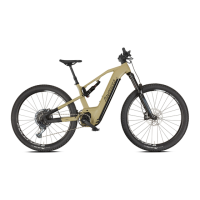38
Suspension
ORIGINAL INSTRUCTIONS | ADVANCED | 01.2022 | 1002021-01
8.1 Function and terms
During compression, the suspension's stanchions sink into
the stanchions and compress the spring in the suspended
component. When the spring is released, the spring inside
pushes the stanchions back into their original position.
Depending on the model, the spring is a mechanical spring
made of steel or titanium or a pneumatic spring with air
chambers.
By adjusting the spring tension, you determine how heavily
the suspension compresses under load or how strong its
resistance to compression is.
Hydraulic dampers provide controlled and adjustable
rebound. By adjusting the compression and rebound dam-
ping of the dampers, the speed at which the spring com-
presses or decompresses can be determined. In general: The
stronger the compression/rebound damping is set, the more
sluggishly the suspension moves; the weaker it is set, the
more smoothly/quickly the suspension moves back to its
original position.
The term sag refers to the compression caused by the cyc-
list's body weight. As a rule, the optimal sag is 15-30 % of
the total spring travel: The suspension should only compress
by a few millimetres when the cyclist sits on the saddle.
8.2 Suspension warnings
WARNING
Risk of accident and injury!
An incorrectly adjusted suspension can affect the ground
traction of the e-bike depending on the road surface. This
increases the risk of accidents and injuries. There is a risk
of injury if the suspension components under tension are
not handled properly.
f Have the basic adjustment of the suspension carried
out by the bicycle dealer.
f Always have suspension forks, rear frame shocks and
suspension seat posts removed and repaired by a
bicycle dealer.
NOTE
Risk of damage!
Incorrect adjustment/handling can damage suspension
components.
f Always have pneumatic suspension components
adjusted by a bicycle dealer.

